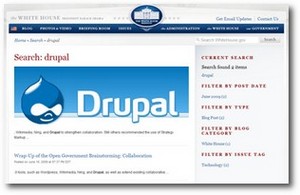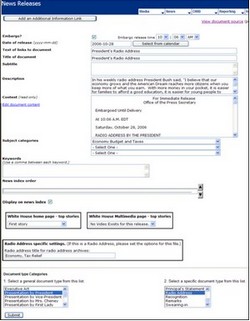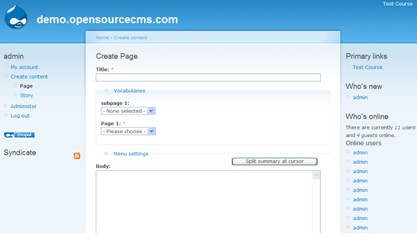This past weekend, the Associated Press reported that the White House was moving to an open source content management system (CMS) known as Drupal. Many among the tech set have praised the move including Nancy Scola from techPresident who was among the first to write about the change in her post, WhiteHouse.gov goes Drupal. A good read.
 For those not familiar with what this actually means, a CMS is basically the back-end (not visible to visitors) of a website that allows the administrators (owners) of the site — often non-programmers — to easily organize site navigation and add content designed to appear on the front-end.
For those not familiar with what this actually means, a CMS is basically the back-end (not visible to visitors) of a website that allows the administrators (owners) of the site — often non-programmers — to easily organize site navigation and add content designed to appear on the front-end.
For most CMS solutions, the user experience is pretty simple, usually consisting of a password protected login, options for varied user permissions for approval and forms with specific fields based on type of content such as text, photos, audio and video. Once entered and saved, the CMS stores the information in the back-end database and displays the content on the front-end when called up by a site visitor.
In the early days of the Internet, many developers created unique proprietary CMS solutions for their staff and clients to save time and streamline the process of maintaining a timely and relevant site. Today, there are hundreds of options out there to choose from. Check out this list from CMS Matrix.
Open source is basically the idea that code doesn’t have to be authored or owned by one person, group or company but rather by a public community of developers free to collaborate, write code, make updates and help advance newer software versions for all to share and benefit. For a more specific description of open source, let’s go to Wikipedia which is, ironically, a type of open source resource for defintions:
Open source is an approach to the design, development, and distribution of software, offering practical accessibility to a software’s source code. Some consider open source as one of various possible design approaches, while others consider it a critical strategic element of their operations. Before open source became widely adopted, developers and producers used a variety of phrases to describe the concept; the term open source gained popularity with the rise of the Internet, which provided access to diverse production models, communication paths, and interactive communities.
Before commenting on the recent upgrade, I did want to set the record straight on a couple things regarding the history of WhiteHouse.gov and the previous CMS.
To get a better understanding of the complete background, I spoke with a couple of my former White House colleagues who were federal government employees in the Office of Administration (OA) of the Executive Office of the President (EOP) back during the transition from President Clinton (42) to President Bush (43).
As I have mentioned before, in my opinion, President Clinton is truly the first Internet president, meaning he was the first to launch a White House website. Here’s what WhiteHouse.gov looked like circa November 1995. Not too shabby at the time. Evidently, in the late 90’s, updates to the site were a bit of a chore. They had to be made manually via files copied to tapes, then physically carried between floors to upload them onto the server a few times a day. Typos could mean a little more exercise that day. Toward the very end of President Clinton’s second term, an automated system was put in place but it wasn’t capable of managing an entire new site for the next four to eight years.
In 2000, with the transition to President George W. Bush’s Administration approaching, a few EOP programmers got together to create an internal homegrown Perl based solution designed to manage basic content needs for the new president’s site. Why Perl? Two reasons. First, Perl was a common programming language at the time, generally used for similar projects. Second, out of the other programming options available, those who were actually developing it knew Perl the best!
(Update from a former EOP insider: “It should also be noted that Perl was picked because the Tool started out as an e-mail to web page processing script. The original tool was developed to solve the problem of posting press releases to the web site automatically. On weekends and after hours, there was no IT staff to do it … so the tool was born of that. Perl as handler script to parse e-mail text into an HTML form and post to the web site. Then it just grew and grew… initially it was all about automation. Only during the later years [sic] did it start into more of your standard (term used loosely) CMS.”)
 Out of this collaboration, a completely new and unique solution was born which we affectionately (most of the time) called, “The Tool.”
Out of this collaboration, a completely new and unique solution was born which we affectionately (most of the time) called, “The Tool.”
Over time, as newer site versions and features were rolled out on the front-end, the Tool scaled with it and was updated accordingly to support them including many things it wasn’t originally designed to do such as creating on-the-fly printer friendly alternative text pages (508 compliance) and digital image processing.
In March of 2007, we launched a new (and final) version of WhiteHouse.gov under President Bush. However, even with the new design and improved functionality for users, the Tool remained in place on the back-end. It was tweaked and updated, but the foundation was the same. We considered options to deploy a new CMS, but personally I wanted to be a good steward of taxpayer money and didn’t think it was prudent to spend a couple million dollars on something that was only going to be used for a year and a half or so before being shipped off to the National Archives and Records Administration (NARA) in January 2009. As a result, the site continued using the Tool all the way up until Inauguration Day.
Several months prior to Election Day, and in a very similar scenario to the Clinton-Bush transition preparation in 2000, career federal employess in EOP’s OA division gathered to begin planning for the next president’s website — whether for Sen. McCain or Sen. Obama, nobody knew. They initiated a review of the most effificient, secure CMS solutions. After the completion of the thoughtful, competitive procurement process, General Dynamics Information Technology (GDIT) was awarded the contract and immediately began work on a new CMS for the 44th President of the United States.
Many stories have reported that President Obama’s team inherited an “old proprietary CMS which has been used by WhiteHouse.gov since the Bush Administration” built and executed by GDIT. However, that isn’t true. As I mentioned earlier, President Bush’s website, CMS Tool and all, was taken offline at 12:00 PM ET on January 20, 2009, President Obama’s Inauguration Day, and ultimately sent to NARA.
President George W. Bush is the first digital president, meaning that he is the first to have his entire presidency captured online via WhiteHouse.gov in the form of transcripts, photos, video and audio. However, Web 2.0 and social media was just gearing up around the time I left the White House in May 2007.
Clearly, the campaign had a huge impact on the growth of the Internet through social media and rapid programming advancements (WordPress 2.8.5 is now available already? I just upgraded to 2.8.4 two weeks ago!) but many of the tools that are being used today either weren’t available to us or hadn’t been tested or matured to the point that we could utilize them effectively within the E-Gov guidelines, privacy policies, security procedures and budgetary limitations that often presented challenges.
To put it in perspective, from 2005-2007, MySpace was the most popular social network, Facebook was locked down to only college students with .edu email addresses, YouTube had recently been purchased by Google but was still growing and Twitter had just launched in March 2007 at SXSW in Austin.
There’s no question that the increased adoption of open source backend solutions in the private sector, and now in government, represents yet another evolutionary step in the rapid growth of the Internet. As these tools become more prevalent, users will be able to better connect and collaborate on shared platforms which only improves the potential for digital public engagement in shaping our democracy.
Congrats to the entire White House new media team!

Want to give it a try? You can actually demo Drupal yourself (and many other open source solutions) courtesy of opensourceCMS.com or you could save yourself some time and just go hire the best in the business!
MEDIA
Podcast: The Right Doctor with David Almacy
[gplayer href=”http://takethatradio.com/shows/rd/RD057.mp3″](Dr. Melissa Clouthier, The Right Doctor, 11/05/09)[/gplayer]
WhiteHouse.gov goes Drupal (techPresident, 10/24/09)
RELATED
White House opens Web site programming to public (Associated Press)
Before Drupal, There Was “The Tool” (techPresident, 10/30/09)
For Drupal Enterprise Software in White House, It’s One Step Forward, One Step Back (IT Business Edge)
Whitehouse.gov could be a springboard for Open Source for America (InfoWorld)
WhiteHouse.gov on Drupal: A skeptic weighs in (OhMyGov)
Whitehouse using Drupal? (Drupal News)


11 Responses